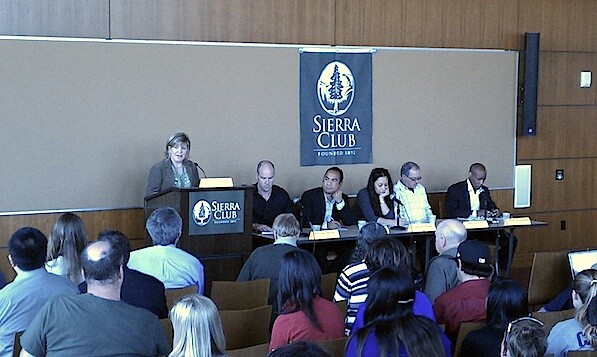Clean Energy or Not, Some Predict Higher Rates from the LADWP

Mayor Villaraigosa pledged to rid Los Angeles of coal-burning power plants by 2020. But is this goal realistic?
The question was twice posed on Monday to a panel of five environmental heavy-hitters in the Los Angeles Clean Energy Forum, a part of the Sierra Club's Beyond Coal Campaign at the University of Southern California. Molly Peterson of Southern California Public Radio moderated.
"It's not that difficult of a challenge," Michael Brune, Executive Director of the Sierra Clubsaid in response to the 2020 agenda. He then consolingly placed his hand on the shoulder of Romel Pascual, who is the Deputy Mayor of Environment for the City of Los Angeles. Indeed, a lot rests on those shoulders to make the deadline. The audience laughed.
The Los Angeles Department of Water and Power is the largest city-owned utility in the United States. Pascaul said it is "highly dependent on coal," currently receiving 30%-40% of its electricity from dirty coal-fired power. It's not a question of whether Los Angeles can wean itself from coal, Pascual said, it is a question of "how quickly."
All of the renewable resources are alternative contenders, but for cost effectiveness it's a matter of scope. "Large scale solar and wind make sense financially," Pascual said.
Panelist Mark Bernstein, Managing Director of USC's Energy Institute, also focused on the fiduciary. It's not fuel that's necessarily the problem, Bernstein argued. It's about the internationally traded costs of steel, copper and cement, and the establishment of structure.
Bernstein prognosticated that energy rates would double in the next few years, regardless of the coal-free agenda. Hitting the pocketbook would likely cause consumer backlash.
"This is why I'm no longer in politics," Bernstein laid out plainly. "The rates are way too low."
"I'm glad that Mark said it, not me," Pascual later quipped. "It's water, electric, sewage, and gas all in one... it's expensive." (An audience member, Gary Polakovic of Make Over Earth, tipped that perhaps they had read Jim Newton's op-ed piece in the LA times that morning, which had made the same argument about the need for a rate increase.)
"It's not just about the cost of concrete, it's about the cost of health care," Brune later built on Bernstein's argument. Over 100 billion dollars a year are spent on health costs associated with coal, which is worse than smoking tobacco, Brune said.
Graciela Geyer, Lead Organizer of SCOPE (Strategic Concepts in Organizing and Policy Education) contended that these health and economic issues impact under-served communities in the Los Angeles community most, but can also provide opportunity. "Create good jobs and safe jobs...that will lift families out of poverty." This kind of a "municipal retrofit" will enable under-served communities to join in the movement. When we exclude the social aspects of the environmental equation, she said, we're missing a major opportunity "to bring people along."
Jeffrey Richardson, President and CEO of Imani Energy, Inc. cautioned that focusing on job training willy nilly could be a false path. He believes that intent may be good, but if there's no market, "people are being trained for jobs that aren't there." He suggested increasing jobs in sales. "Sales jobs increase 30% or more every year, even in this economy," he said.
Given the university setting, youth was another focus of the afternoon. Student organizers scurried around in matching Beyond Coal t-shirts. As the leading private purchaser of energy in the LA area, USC is particularly attuned to the issue. Brune believes that the next generation has the real moral authority to push for new initiatives because the world is their inheritance.
"How things change when you have kids," said Brune during his introduction. "Right when [my wife and I] had our little girl was when climate change was off the charts." When considering the world he was delivering to his progeny, Brune mentally mapped out the environmental devastations that would occur as she aged. He dreamed, instead, of being able to say, "there used to be a coal plant right there."


